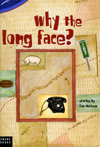Why the Long Face?
Ron MacLean, author of the 2004 novel Blue Winnetka Skies, surges forward with his new collection of short stories, Why the Long Face? The collection’s witty, and at times wry, take on the ordinary stuff of life works to subtly reveal the extraordinary nature hidden in even the most common events.
Ron MacLean, author of the 2004 novel Blue Winnetka Skies, surges forward with his new collection of short stories, Why the Long Face? The collection’s witty, and at times wry, take on the ordinary stuff of life works to subtly reveal the extraordinary nature hidden in even the most common events.
One of this book’s recurring themes, laughter even in the face of life’s difficulties, probes the reader to ask, like the lead character in “Symbiosis,” “Why the long face?” In “Why I’m Laughing,” the speaker watched his mother laugh off his father’s indiscretions; he later, as an adult, exhibits the same ability. The story, in many ways, comes down to a tale of how family comes together and how they separate, imprinting their lives on those who surround them, marking their influence no matter how brief their presence may be.
“Between the Bar and the Telephone Booth” is no less exemplary, no less a tale of fining down the process of the continual development of self. Drawing on the example of a top-rate musician, protagonist Jack provides insight into ways some people approach that process:
Thelonious Monk was a good man. There’s an apocryphal story about how Monk lost his recording contract, lost his club card – no one wanted to hear his music. So he holed up in his apartment for nine years working to make the music pure enough – so completely itself that maybe people could begin to hear it.
Jack’s conversation with the bartender proves enlightening toward MacLean’s efforts:
“What’s the thing that makes life vital, Robert?” I said to him. “What gives shape to our existence?”
Robert washed glasses at a little sink under the bar. He raised an eyebrow at me.
“It’s having a purpose larger than yourself. A context, where you’re part of something. Where you can make a contribution and see it. Think about Monk […] It wasn’t about music.” Robert’s eyebrow got higher and his lips got thin. “Or it was, but only because music was the way for him to get to the other thing – the essence.”
Other stories touch on truths about the self, most notably “Strange Trajectory: A Story of Phineas Gage” and “Mile Marker 283.” The tale of Phineas Gage, a man who suffered a disturbingly severe head injury while laying rail in the days before antibiotics and who lived to tell about it, is a close examination of the literal parts of us and how they make us who we are – a take on our essential human-ness. The story also speaks to the loss of self and to an exploration of the soul, as does “Mile Marker 283,” where a woman who suffers from severe memory impairment and bouts of narcolepsy, struggles to rein in images at the fringes of memory and to reconcile them with her identity.
Still other tales in MacLean’s collection function as lovely satire and, incidentally, commentary of the world outside the self – but the focus is still on seeing, on interpretation. “Figure with Meat” is a story that attempts to marry literature and art, where each section is a sketch (“fig. 1.4 [rust]”), the language fittingly vivid and the characters carefully placed into position, every scene an analysis of where they are in their particular moment. In “fig. 1.6 (miserere),” MacLean writes of his painterly protagonist Otto (ironically, a painter whose vision is fading), “Paint what you see. What does Otto see? How to express that no matter the cause, the light is fading.” If, in “Figure with Meat,” art history meets contemporary vision, “Las Vegas Wedding, Or, Buffy the Vampire Slayer Meets Gertrude Stein at the Luxor” marries pop culture with literary modernism. All to hilarious end, of course, and all in good fun.
Stories like “terror/home” carry things a step farther, and are more thought provoking in that they touch the reader from a place firmly planted in the national contemporary moment. As a post-modernist (post-post-modernist?) reaction to the events of September 11, “terror/home” does an interesting thing, juxtapositioning the realm of the tragic with that of the familiar, with effects touching on the immediacy of devastation, both directly and to an American consciousness reeling from the unexpected. In some ways, “terror/home” is almost too jarring, contains too many stories and lives. But then again, perhaps that is the point – the suddenness of multiple stories, lives, being thrust into the collective American psyche. And the effect, like September 11, is disorienting. For instance, numbered sections by turns depict ordinary life and that of a rescue worker digging through the rubble, or particular acts of terrorism. I kept waiting for the lives, the characters, to come together, but when they didn’t, realized that their connection is in their common experience.
Why the Long Face? is a powerful collection of works that are at times entertaining, often thought-provoking, and that sometimes contain the moxie of someone commanding attention … Hey, this is important. Shut up and listen. But come what may, MacLean seems to insist, what good is to be gained by moping about the bad stuff? Why not laugh it off. Life goes on.





